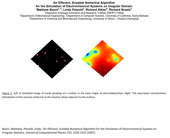Highlight
An Efficient, Scalable Numerical Algorithm for the Simulation of Electrochemical Systems on Irregular Domains
Achievement/Results
The formation of ultrafine metal films and clusters by electrochemical deposition is a critical step in fabrication of nanoscale systems including sensors, microelectronic devices, and other significant technological application for which multiscale, multiphenomena simulations are needed. The key challenge is to simulate the complex role that trace quantities of solution additives play on nucleation, growth and shape evolution of deposits. The process of identifying the most sensitive parameters and estimating their values requires significant computational resources. A central focus of this multidisciplinary, IGERT/ITR project has therefore been the development of ultrafast and reliable algorithms and software for model development, validated by experimental data. New algorithms were developed and dynamically linked for the multiscale simulation of electrochemical nucleation on irregular domains with moving boundaries. The nucleation, growth and surface chemistry of a metal electrodeposition under the influence of additives was described by an island dynamics algorithm. The transport of solution-phase species was described by a finite volume discretization of equations for diffusion and migration with electroneutrality constraints. The solution phase was discretized in three dimensions, with the effect of explicitly describing the concentration profiles surrounding growing nuclei and fully accounting for the effects of mass transport on the surface morphology in electrochemical systems. The two models were coupled by a new semi-implicit method.
Address Goals
These results advance Research Infrastructure in Computational Science and Engineering through the development of a new algorithm for the simulation of partial differential equations for diffusion and migration with electroneutrality constraints which is orders of magnitude faster than previously known methods, and through the development of a new, robust technique for communicating information across scales even in the presence of stiffness. The latter technique is broadly applicable to multiscale problems across science and engineering. The resulting highly accurate and efficient methodology advances Discovery in Materials and technology by enabling simulation and design optimization of copper electrodeposition in the fabrication of the next generations of computer chips.






